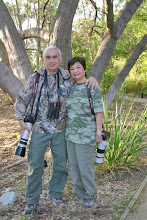Deja vu - noun - a feeling of having already experienced the present situation. French literally meaning "already seen".
Our experiences in Subic the past two days had been quite deja vu-ish . First of all, it was almost the same dates that we were here last year - just one day's difference. Then, for the most part, the scarcity of the birds were an eerie repetition of 2013's dearth of avian sightings. Finally, on a positive note, where we met a pair of newbie birders (Mr & Mrs Jorge Abiva Garcia) before, we had the same experience this year when we met Dr. Rannie Aguilar and his family.
It was on a Sunday afternoon right at the entrance towards the Nabasan trail that we met the Aguilars. Since it was their first time to go birding in Subic, we offered to take them around the better known birding areas. For a newbie, Rannie had very sharp eyes. It was his keen observation skills that enabled Cynthia and myself to see some of the birds in the forest. Example number one: while I was busy taking pictures of the Whiskered Treeswifts, Rannie and his son's attention were somewhere else. When I approached them he pointed to a Green Imperial Pigeon. It took me a while to spot it.
By the road to Hill 394, he asked me "Did you see it?" I shook my head. He then directed me to the tree trunk across the road. A White-bellied Woodpecker was busy hunting for food.
We went to the Crown Peak area late in the afternoon. Although birds were quite numerous - Blue-naped Parrots, Black-naped Orioles, Blue-throated Bee-eaters and Yellow-vented Bulbuls were all preparing to settle in for the night - it was already too dark for us to get any decent shots. This was very similar to our experience last year.
We agreed to meet up again the following morning inasmuch as the hotels where we were staying in weren't that far from each other.
It was still dark when we arrived at Nabasan Trail the next day. We waited patiently hoping we would encounter an owl, but none appeared. The sun was already shining brightly when bird activity commenced. Green Imperial Pigeons were still too lazy to leave their roosts. It was the Guaiaberos that were up and about.
We moved on when the bird activity dwindled somewhat. Along the exit trail, Cynthia heard some mewing sounds. We parked our cars and looked for the source of those strange noises. I looked at Rannie who was shooting at something. When asked what it was, he showed us a full body shot of a Rufous Coucal! "They already hid in the bushes," he informed us. I was devastated. The Rufous Coucal is one of my most sought after species. We've been to Subic many times and not once have we seen them. Cynthia noticed the dour look on my face. "We'll come back again tomorrow and we'll see them then," she said consolingly. Still my heart was pained. So I prayed. We were about to board our vehicles when the mewing calls once again resounded in the crisp morning air. One, two, three coucals flew across the road calling to each other. One of them perched in full view. My prayer had been answered. My last lifer for the year was now in the bag.
My wife and I needed to go back to our hotel before 10 am so we could avail of the free breakfast. A little after nine we said goodbye to our new friend and excellent bird spotter. He and his family would be going back to their home in Lucena after lunch so he wanted to make the most of his birding morning.
There weren't new birds along Nabasan trail and the Botanic Garden when Cynthia and I returned after breakfast. Our afternoon birding only yielded a Philippine Green Pigeon.
Tuesday morning, we hit the road to Hill 394 again. Like last year, another target bird, the White-fronted Tit was a no-show. That place only yielded a Luzon Hornbill and a pair of Sooty Woodpeckers.
Just like yesterday, we had to go back to our hotel for our breakfast. We both agreed that we would go home after our morning meal. To borrow the words in my blog one year ago: Our trip was not that productive bird-wise but we did gain new friends. For my wife and myself that is still a plus. And we got a lifer this time.
Hen Harrier at Long Last!
1 week ago

























































